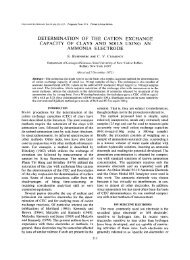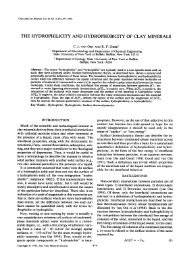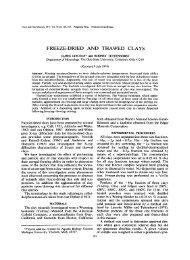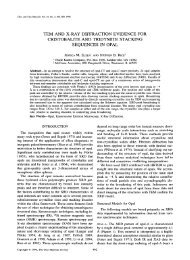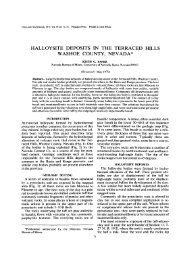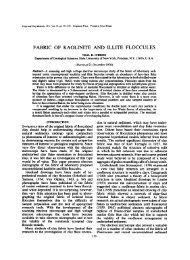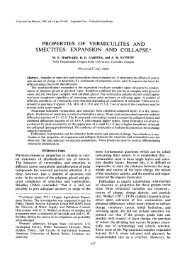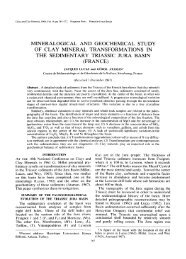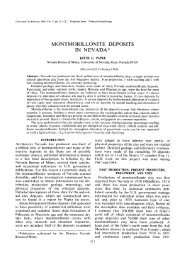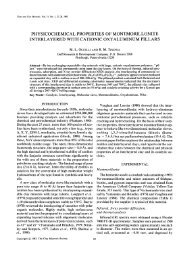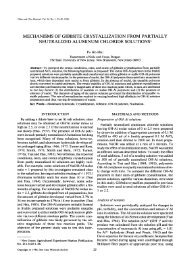formation of halloysite from feldspar: low temperature, artificial ...
formation of halloysite from feldspar: low temperature, artificial ...
formation of halloysite from feldspar: low temperature, artificial ...
Create successful ePaper yourself
Turn your PDF publications into a flip-book with our unique Google optimized e-Paper software.
FORMATION OF HALLOYS1TE FROM FELDSPAR<br />
15<br />
Table 1. Studies on recent rock weathering in which <strong>halloysite</strong> has been identified<br />
Study<br />
number Authors Date Geographic area Parent rock<br />
l Alexander, et al. 1943 Maryland, U.S.A. gabbro, amphibolite<br />
2 Birrell, et al. 1955 New Plymouth, New Zealand volcanic ash<br />
3 Sudo and Takahashi 1956 Japan glassy tuff<br />
4 Hay 1960 St. Vincent, B. W.I. andesitic ash<br />
5 Beutelspacher and van der<br />
Marel 1961 Java, Sumatra, Celebes, Papoealand rhyolite, granite, basalt,<br />
serpentine<br />
6 Bates 1962 Hawaii, U.S.A. basalt<br />
7 Gastuche, et al. 1962 Kivu, Republic <strong>of</strong> the Congo basalt, volcanic ash<br />
8 Robertson 1963 Oregon, U.S.A. tuffor pumice<br />
9 Simonette and Bauleke 1963 North Queensland, Australia basalt<br />
l0 Patterson 1964 Hawaii, U.S.A. basalt<br />
l I Kato 1964-65 Shinshiro City, Japan granodiorite<br />
12 Nakamura and Sherman 1965 Hawaii, U.S.A. basalt<br />
13 Fairbairn and Robertson 1966 Sierra Leone kimberlite<br />
14 Hendricks, et al. 1967 Northeast California, U.S.A. andesite<br />
15 Wolff 1967 Maryland, U.S.A. quartz monzonite<br />
16 Ferguson 1954 Queensland, Australia basalt<br />
17 Weyl 1954 El Salvador dacitic ash<br />
18 Hosking 1957 Australia granite, basalt, sediments<br />
19 Moberly 1963 Hawaii, U.S.A. basalt<br />
20 Grant 1964 Georgia, U.S.A. biotite-plagioclase gneiss<br />
21 Ostrowicki 1965 Poland serpentinite<br />
22 Beaven, and Dumbleton 1966 Trinadad, Jamaica, Grenada,<br />
Barbados, B.W.I.<br />
votcanics, meta-sediments<br />
23 Uehara, et al. 1966 Hawaii, U.S.A. pahoehoe lava<br />
24 Grant 1963 Georgia, U.S.A. granite<br />
25 Lisitsyna 1966 Batumi, U.S.S.R. labradorite-augite porphyry<br />
26 Hardon and Faveje 1939 Java andesitic tuff<br />
27 Kim and Kim 1964 Kyongsang Namdo, Korea anorthosite<br />
The effect <strong>of</strong> climate coupled with conditions <strong>of</strong><br />
good drainage have resulted in deep chemical<br />
weathering <strong>of</strong> a considerable part <strong>of</strong> the predominantly<br />
igneous bedrock. Halloysite .4H20<br />
seems to be the most common clay mineral formed<br />
in the weathering products <strong>of</strong> a variety <strong>of</strong> rock types<br />
in Hong Kong. Clay mineral data on weathering<br />
products <strong>of</strong> this region will be published in another<br />
study.<br />
Soxhlet extraction units (Fig. 2) were used in the<br />
<strong>artificial</strong> weathering <strong>of</strong> a potassium <strong>feldspar</strong><br />
(microcline) and a plagioclase (ANT0) <strong>feldspar</strong><br />
(Table 3). The technique is that first used by<br />
Pedro (1961) in similar leaching studies. Distilled<br />
water in the distilling flask was maintained at its<br />
boiling point by a heating mantle. Condensation<br />
was achieved by the water-cooled condenser at the<br />
top <strong>of</strong> the apparatus <strong>from</strong> where the water fell onto<br />
the <strong>feldspar</strong> be<strong>low</strong>. The water level in the chamber<br />
containing the <strong>feldspar</strong> would rise to the level <strong>of</strong> the<br />
top <strong>of</strong> the siphoning tube and then would drain back<br />
into the distilling flask and the cycle would be<br />
repeated. The <strong>temperature</strong> <strong>of</strong> the water leaching<br />
the <strong>feldspar</strong>s was approximately 77-78~ and the<br />
pH was about 6-5. Approximately 71 <strong>of</strong> water<br />
f<strong>low</strong>ed over each sample per day, and leaching <strong>of</strong><br />
both <strong>feldspar</strong>s was continued for 140 days. The<br />
<strong>feldspar</strong>s were broken into pieces <strong>of</strong> approximately<br />
89 in diameter so that alteration products<br />
that might form could be related to specific cleavage<br />
surfaces.<br />
The <strong>artificial</strong> weathering conditions used in the<br />
laboratory parallel the natural weathering conditions<br />
in Hong Kong, i.e. a hot, humid environment<br />
with high rainfall and good drainage; however, for a<br />
given period <strong>of</strong> time the amount <strong>of</strong> <strong>artificial</strong> rainfall<br />
far exceeds the amount <strong>of</strong> natural rainfall. Pedro<br />
(1961) has pointed out that the absolute humidity<br />
maintained in the Soxhlet apparatus is so high that<br />
the amounts <strong>of</strong> dissolved gases, i.e. oxygen, and<br />
carbon dioxide, are much <strong>low</strong>er in the extractor<br />
than in normal rainfall. In addition, the <strong>temperature</strong><br />
<strong>of</strong> the <strong>artificial</strong> rainfall is considerably above natural<br />
rainfall. Nevertheless, it should be noted that <strong>temperature</strong>s<br />
that have been recorded in the top few<br />
centimeters <strong>of</strong> soils in the humid tropics approach<br />
C.C.M. Vol. 17No. I-B



